Domestic cats come wrapped in hundreds of colors, patterns, and fur varieties. There are so many variations that it might seem impossible not to mix them up.
However, if you want to dive into the amazing world of cat colors and shades, focus on this article. It is a cat guide to all the various cat colors and patterns they come in.
What are the different colors of cats? What is the most common color for a cat? How are cats color determined? And what is the rarest color of cat? Or what type of cat do I have?
Below you’ll find the answers to these most-asked questions as well as many other ones.
Coat Color
Cat colors, patterns, and fur peculiarities are known as a calling card for any feline. Among the most frequent are white, red-based, and black-based colors of cats.
White
The first and main color in a cat color chart is, of course, white. The cats with white colored coats and without any markings are related to the type of a solid coat pattern. Such felines usually have pink noses and toe beans. The cat’s eye colors can be golden, blue, copper, green, and even different eyes.
Red-Based Colors
Red (also known as orange and ginger) and cream are the two red-based colors of a cat’s coat. Cats with red-based coats are genetically males. This color is often mixed with a tabby pattern. It is really difficult to find a cat with a solid red coat color.
Black Based Colors
Black based colors include black, blue, chocolate, lilac, cinnamon and fawn cats coat colors. Blue, lilac, and fawn are considered as diluted shades of black color that add uniqueness and special attractiveness to some cat breeds.
Black
Solid black cats are extremely popular as well as solid white ones. Sometimes (in summer) due to the sun rays, solid black cats may seem slightly brownish.
Blue
Although a lot of cat fans call this color grey and it looks like grey in most cases, in the cat color chart this color is known as blue. It can vary from light blue-grey to deep bluish-grey. Blue is typical for many breeds and mixed-breed felines as well.
Chocolate
When it comes to a chocolate coat color, you should know that this is one of the most popular variations of brown. It is a warm deep brown color. The cats with chocolate coats often have brown-pink or milk-chocolate paw pads and chocolate nose leather.
Lilac
Lilac is a hue of light grey-brown with a pink shade. The paw pads and nose leather of the cats with lilac coats can be lavender pink.
Cinnamon
One more shade of brown is cinnamon. It is a warm light brown color with distinct red hues. The paw pads of cats with cinnamon coats can be cinnamon brown as well as the nose leather.
Fawn
A diluted variation of cinnamon is called a fawn. It is a bit lighter than a lilac color. Pinkish fawn shades are common for the paw pads and nose leather of felines with such a particular coat color.
Cat Coat Colors and Patterns
Types of cat coat patterns are a mix of colors in a peculiar layout. There are six core coat options: Solid or Self-Color, Bi-Color, Tabby, Tortoiseshell, Tri Color or Calico and Color Point cat color patterns. Let’s look at each of these in turn.
Solid / Self-Color
A solid or self-color cat is any feline that is one solid color. This is a cat coat that doesn’t have any recognizable spots, stripes, ticking, patches of white, or shading.
Surprisingly, it is typical for very young kittens of this coat type to have a splash of a secondary color. But when the cat grows, the extra hairs disappear and the feline’s coat becomes solid colored all over.
However, in case the mature cat’s coat contains even a few hairs of another color, this cat isn’t considered a solid colored one.
Bi-Color
A bi color cat is known as the feline that has solid patches of color combination – approximately half white and half another color.
There are a huge variety of bi-color cat coat options. Most people classify their cats as bi-color typed if it is a magpie cat, a harlequin cat, or a cat with random spotting. This type of fur pattern is common for mixed breed felines.
Tabby
When it comes to the most common coat type, this is all about tabby cats.
Well, what is a tabby cat? Mostly, “tabby” means a striped cat coat. There are four main types:
Mackerel tabby
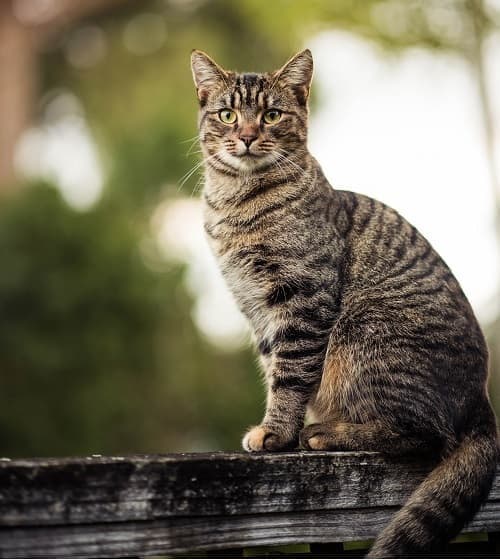
Mackerel tabby have acquired their name from the mackerel fish that has vertical markings. The mackerel tabby cat has vertical lines that run down the spine and resemble tiger stripes.
The stripes can be either solid or broken. This pattern is typical in wild cats, but some domestic breeds (Norwegian Forest Cat or Maine Coon) are also distinguished by this striking pattern. The nose color of mackerel tabby cats is pink with a ring of black pigmentation.
Classic tabby
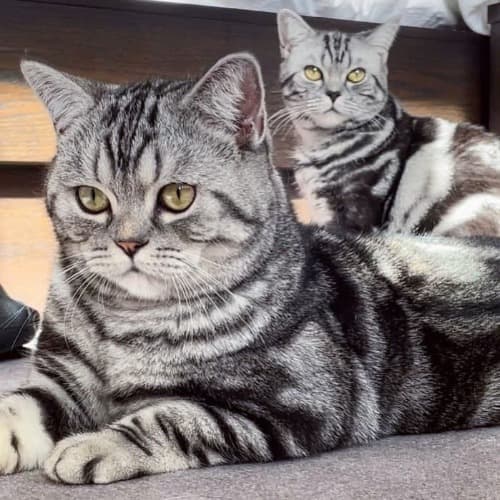
@twosilverfloofs
A classic tabby cat, also known as blotched or marbled, features the classic “M” – shape on the forehead and thick curving bands on the sides of the body; these bands resemble a bullseye.
The nose of these cats is usually pink, and the eyes can be brown, yellow, gold, or green.
Spotted tabby
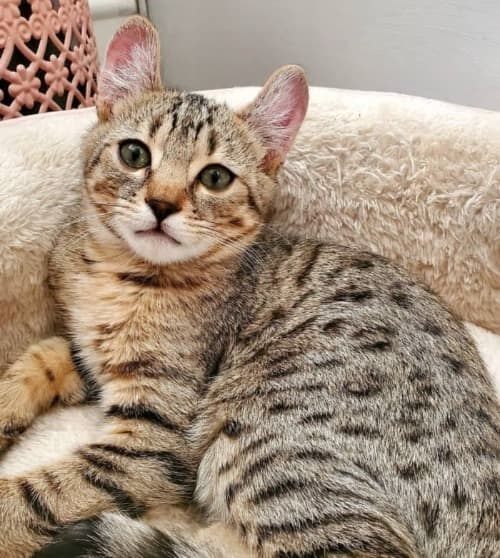
@deez_nutz_cat
The spotted pattern is characterized by small spots that form a specific pattern on the cat’s body. These spots can be more elongated or less elongated. This pattern is common in wild cats or exotic domestic breeds. The characteristics of spotted tabby cats are the following:
- Eyelid skin is dark and surrounded by light fur, giving a cat an extremely dramatic look.
- They have a notable dark “M” on the forehead.
- Whiskers are either light or dark.
- The darkest part of the color is found on the legs, tail, and paws.
Ticked tabby
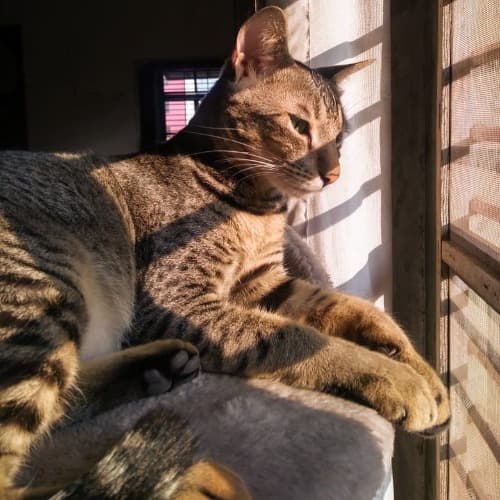
@tillutheterror
Ticked (also known as Agouti) tabby is the rarest pattern. Actually, there are no traditional tabby markings (lines or spots), instead, these cats have agouti hairs (individual hairs with light and dark bands). Different colored bands are located along the length of the cat’s coat.
This pattern is especially popular in two cat breeds (Somali and Abyssian). However, this pattern is not common in the wild cat population.
Black tabby
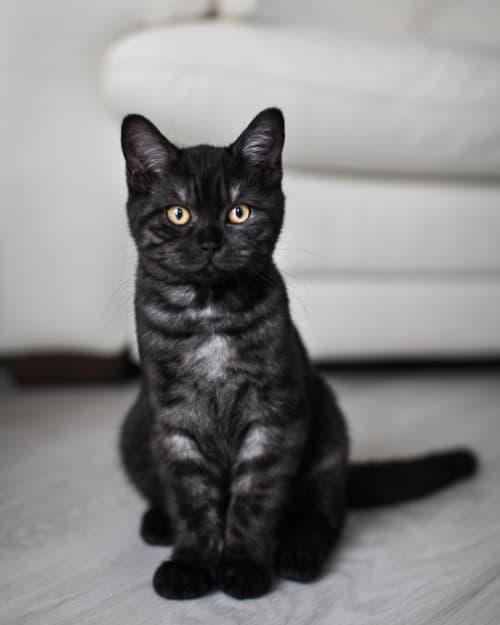
@simba_thesilvertabby
Black cats have a distinctive tabby pattern – a shiny swirl of black and gray shades over the body, including a special “M-shape” on their foreheads. These lines can have faint markings in certain lights. Black tabby are also known as attābī.
This name is connected with a special silk taffeta with woven waves which is produced in Baghdad. This pattern is found in domestic cats and wild cats (cheetahs, tigers). Black tabby cats are easy-going, friendly, and loyal.
Blue tabby
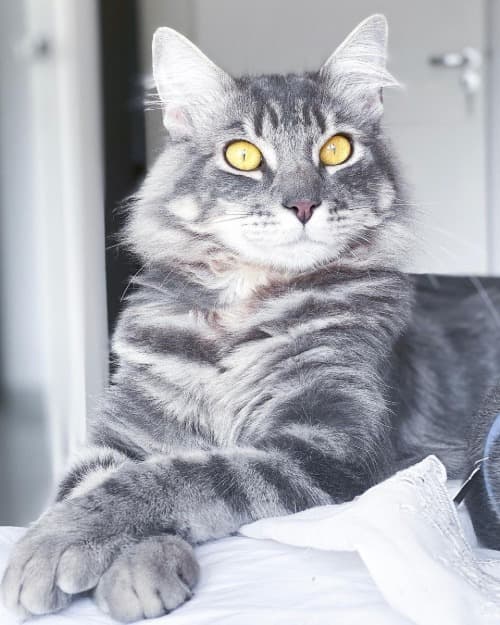
@trigatos
This color means that gray and blue colors prevail in the coat of the cat. The background color of the coat has a light blue tint (fawn), and the stripes are deep blue.
All tabby cats have fine lines on their faces, distinctive markings around the eyes, and a distinct “M” on their forehead. The paw pads and nose are often pink or blue. Blue tabby cats have beautiful yellow-orange or blue eyes.
Brown tabby
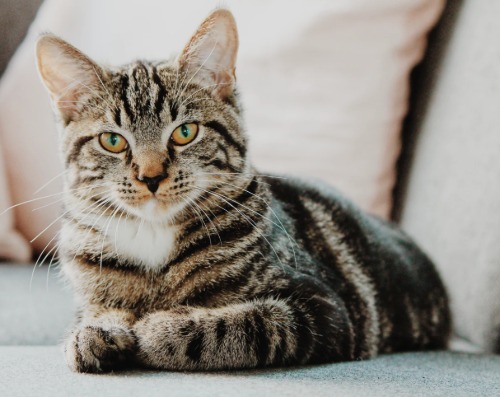
Brown tabbies have brown or bronze fur with a black tabby pattern. Sometimes brown tabbies have a white tummy and white paws. The white color can be either present or absent on the face.
Their eyes can be copper, orange, yellow, or brown with a black rim. The paw pads are black or brown. Maine Coons, British Shorthairs, Bengals, and many crossbreeds can have this pattern. Brown tabby is distinguished by their extremely loving and affectionate nature.
Brown ticked tabby

@snobbyduche
Brown ticked tabby has a ticked pattern on a cream or brown body. A solid dark brown fur can be found on their legs and ears. Their eyes are copper, orange, or green. The nose and paw pads are black or red.
Tabby cat names are often connected with their special tabby cat coloring and a distinctive M-shaped marking on the foreheads.
The most popular tabby cat breeds are American Curl, American Bobtail, Domestic Shorthair, American Shorthair, Maine Coon, Abyssinian, Oriental, and Ocicat.
Chinchilla
The Persian cat breed has the chinchilla coat pattern, which is sometimes referred to as chinchilla Persian. It is a tabby variety with silver-tipped hairs and a pale base generated by the dominant melanin inhibitor gene.
Tortoiseshell
Tortoiseshell or for short tortie cat coat patterns combine two distinct colors: a blend of orange and black sometimes with gold or brown specks.
There are dilute tortie combinations that include shades of cream and blue. Besides, you can see or even have a tabby tortie that can be called a torbie cat. The tabby tortie feline is marked by a tortoiseshell color mix and has a tabby striped pattern on its coat.
Tri Color / Calico
Tri color, calico or bindle cat coat patterns come in black, white and red or ginger cat colorations. Their diluted options include blue and cream color variations. Felines with these cat fur colors are mainly female because of genetic factors.
Color Point
Cat characteristics of color point coat patterns are much darker colors on the cat’s face, paws and tail (beige fawn and light brown cat coat combinations) than on the rest of the body. Among all cat fur patterns, this is the only temperature-related one. This means that the cooler parts of the body have a darker color and with age color point coats tend to go darker.
Cat Colors and Cat Personalities
The link between a cat’s personality and its coat color is definitely real. The researchers from the University of California claim that this link can be easily explained.
It depends on the cat coat coloring pigment (melanin) and the levels of dopamine which can vary and influence brain activity. The study shows that felines with lots of coat coloring pigment are more tolerant of crowded areas and usually adapt quickly to city life.
Most vets around the world accept this theory and offer similar findings. For example, the common tortoiseshell cat with a lot of pigment on its coat is characterized as a highly independent and assertive creature that often does what it wants.
Types of Cat Fur
Cats have coats of various texture, color, and length.
Long-Haired cats
Long-haired cats look regal. Colors and patterns vary significantly, and fur can grow to lengths of up to 5 inches, depending on the breed. Long-haired cats require frequent grooming to keep their coats lustrous and free of knots.
Short-Haired Cats
The most prevalent type of cat, short-haired cats, do not develop fur longer than 1.5 inches. As a result, they require less care than long-haired felines.
Curly-Haired Cats
Curly fur is caused by a genetic mutation. This recessive mutation is seen exclusively in a few cat species, including LaPerm and Devon Rex. Curly-haired cats can have long or short hair that ranges from a loose curl to a full-fledged perm.
Hairless Cats
The Sphynx is a common breed that springs to mind when thinking of hairless cats, but they are not the only ones. Donskoy, Bambino, and Dwelf also refer to the breeds of completely bald cats.
Genetics
And what about genetics? Genetics determine a feline’s coloration, pattern, fur length, and texture.
Some Genetic Reminder
Each feline consists of 19 pairs of chromosomes. Every separate pair includes one father’s chromosome and one mother’s chromosome. Each chromosome has many different genes that exist in various versions.
This version is called an allele. That means that each pair of chromosomes consists of two alleles (options of the parents’ genes). Remember, the same alleles are known as homozygous, and the different ones are called heterozygous.
As you know, an allele can be dominant (A) or recessive (a). This fact has a great impact on the cat’s appearance and, in some cases, on its personality.
So let’s focus on colorations.
Black
The dominant allele for the black color is shown as B, for chocolate – b and for cinnamon – bl. The cinnamon coloration itself is recessive to the chocolate color. Well, when the cat offers the allele BB, Bb and bbl, nevertheless it will be black. When it has bb or bbl, it will be chocolate. In case, it consists of blbl, of course, it will be cinnamon.
Dilute
Let’s remember what colors we relate to the diluted ones? Lilac, blue, cream and fawn. The gene modified with the diluted color is always recessive to the non-diluted one.
D is a mark for the non-diluted allele, b is for a diluted allele. In case the feline has DD or Dd, it will have a dense coat coloration.
The black and red-based colors are likely susceptible to the dilution. Blue is the dilution of black, lilac and fawn are relatively chocolate and cinnamon and fawn is the dilution of red.
White
Being a dominant allele (W) to the non-white color (w), this gene can carry the effect of any other color gene of the feline. It may sound strange but the cat with BB DD tends to be black, but if it is having Ww or WW, the feline will be born completely white and if it has ww, actually, it will appear black.
Red
The R (red) gene is placed on the X chromosome. As we already mentioned, this coat color is typical for males.
There are also two types of alleles: the red (R) allele and the non-red (r) allele. The R gene is dominant and if it presents it causes the production of phaeomelanin and suppression of the black pigment. Male R and female RR cats are born red in color. Females Rr cats are known as calico with a blend of red and black in their coat color.
Genetic Test
Doing a genetic test is a perfect way to know which recessive gene your cat is carrying. This can be so useful for some coat colors, such as lilac and fawn, because it is really difficult to guess without the genetic test what gene can be carried.
The black colors, white genes and dilute modifiers can be identified by the genetic test and definitely shown the two alleles of your feline in order to avoid any surprises in the future. Of course, if you know some information about your cat’s parents and grandparents, you can try to guess but it isn’t certain. In fact, the genetic test is the best option to know everything about your feline’s genes.
FAQ
What are the rarest cat coat patterns?
Cats come in a variety of hues and patterns, but some are more unusual than others.
Albino cats are the most uncommon of all cat patterns. They are exceedingly rare since a kitten must inherit two recessive genes. Therefore, breeding them on purpose is difficult. Albino cats will have a white coat, pink skin, and blue or pink eyes.
Black smoke cats may initially seem solid black cats. On closer inspection, though, you’ll find a strip of white color at the roots of their hair.
Silver cats have black or gray tips. Silver cats with this coloring seem to shimmer. Silver cats can have plain or patterned coats.
What are the most common cat colors and patterns?
The most common colors are black and white.
What is the prettiest cat color?
There is no consensus on this matter since the beauty of the shade is a subjective factor.
Are chocolate colored cats rare?
Chocolate color cats are uncommon because cats with brown coats have a gene mutation that reduces black pigmentation in the coat, resulting in brown coloring. Usually, Havana Brown and the Oriental Shorthair feature this coat color.
Bottom Line
The modern-day domestic feline comes in a wide range of coat color and patterns. We hope that after reading this article the classification of cat’s coat coloration and cat’s coat patterns has become much clearer to you.
Maybe it’ll help you determine the exact type of coat pattern and color of your feline, maybe it’ll be useful when you choosing the new four-legged member of your family. All the same, we tried to provide as much information about coat types and colors as possible to let you make the right choice or identify what cat you have got.
Moreover, a large part of this article is devoted to genetics. Actually, it is important to take the genetic factors into account when it comes to the coat coloration and types of coat patterns.
Read more:
Cat Coat: Silver and Smoke Cats
The post Cat Coat Colors And Patterns appeared first on CatsPurfection.
